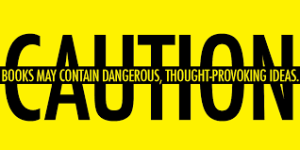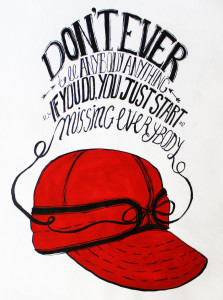The Catcher in the Rye by JD Salinger
Revered by many as one of the greatest works of the twentieth century, JD Salinger’s The Catcher in the Rye is an incredibly controversial and an extremely powerful novel. A book of morally-questionable content such as this finds itself among any school district’s banned books list. However, The Catcher in the Rye has made far greater strides, even landing a spot on the Top Ten Most Banned Books Ever list named by Time Magazine in 2008. While many people admire the distraught main character, Holden Caulfield, there are a large number of people who simply do not, believing his character stands for more than just an angsty teen. The Catcher in the Rye has been banned on the lighter premises of using profanities and being sexually explicit/suggestive, while it has also been banned for darker interpretations of the book, such as being part of a Communist plot, anti-religious, and promotive of homosexuality and perversion. To this very day, this book is continually disputed and banned from school districts in the United States. Was your high school one of the few that were tolerant of Salinger’s thoughts?
Chances are, if you attended high school from 1966-1975, your school district found The Catcher in the Rye unsuitable for high school aged students to read. Unless of course, you were amongst a selected group of students known as the Advanced Placement, then you were permitted to read. This decision was made by a New Jersey school district who determined that AP kids were better able to understand the novel’s universal message and take a greater interest in its teachings.
What exactly is the universal message that this NJ school board is referring to? And why should only the students whose test scores deem them mature enough be granted permission to read it? The novel is centered around a seventeen year old boy with a pessimistic outlook on the world. Holden Caulfield, the main character, describes his journey away from the comfortable life he lives attending private school and into the lonely world all on his own. The reader does eventually find out that his adventure takes place over the course of just a few days, and through deeper analyzation, that Holden is most likely narrating from a mental health facility. Overall, Salinger paints a vivd picture of Holden physically (gray haired, lanky, out of shape) and mentally (perceptive, analytical, resentful, mistrustful) which leads the reader to imagine him as a miserable and dramatic child in need of a wake up call. This is an interesting view because this is how many adults would characterize younger people of today. Not so coincidentally, Holden has no respect for adults with authority, because he knows exactly what they all think of him and his choices.
In many ways, The Catcher in the Rye is largely a coming of age tale, since the majority of the novel is Holden’s thought process and him evaluating and commenting on the situations he experiences. One could certainly argue that the universal message to be extracted from the novel is that it is okay to not be sure of your direction or purpose in life. It is okay to not know what you want to do or where you need to be. It is okay to move at your own pace and to do things that simply make you happy, regardless of if they are socially or morally correct. It is understandable why schools may not approve of their students adopting what they might see as a “lazy” or “leisurely” mindset. However, if that is truly the case, it brings about a familiar question: why give only certain students (AP/Honors students) the power to exercise such an attitude?
So why was The Catcher in the Rye so popularly banned in the first place? The least problematic of the book’s themes would be its obscenity and profanity. Hardly does a page go by where Salinger does not use some form of foul language- his favorite being a curse word that damns a certain religious figure. Salinger is also credited with the development of a few popular phrases today, including the term “screwed up”.
Speaking of religious figures, that brings us to another point on why the novel was originally banned. Whether you’re for or against banning the book, everyone can pretty much agree that Holden Caulfield is nowhere close to a saint (no pun intended). Underage drinking, premarital sex and a pessimistic outlook on life are just some of the things that characterize Holden and turn him into a sort of anti-hero.
In the 1970’s and 1980’s, one school district in the state of Washington took a darker approach to their children reading this book. Parents objected to The Catcher in the Rye because they believed it to be part of a larger Communist plot that Salinger himself was involved in. Not only was Communism threatening the parents of young readers, but many believed their children would be inspired to commit heinous acts of brutality from reading this novel. For example, Mark David Chapman cited The Catcher in the Rye as his motive for killing the legendary Beatles frontman, John Lennon. Other incidences of criminal activity have been linked to the readers of this book, but none in recent years. The most likely explanation for why criminals are inclined to enjoy this book is because it puts their words on paper; it lets them believe someone else out there understands them.
What should not be lost on the reader when analyzing The Catcher in the Rye is the time frame this book was published in. The 1960’s was a time period where self discovery and breaking away from the societal norm was on the rise. People went crazy for a figurehead who was, quite simply, relatable. Someone who didn’t know where they were going but knew they wanted something other than what they had was the key. The similarity factor won over the hearts of young individuals who connected with Holden and saw him as a symbol for hope.
That factor alone is what makes The Catcher in the Rye significantly more important culturally and socially. Many literary critics have commended Salinger for having written a book that completely defines that decade. But if you ask me, this book is more applicable now than it ever has been. In a world where younger generations are at cross roads in their lives and attempting to succeed despite the odds against them, perhaps a symbol of hope is exactly what is needed for America’s youth to depend on. Perhaps The Catcher in the Rye will continue to fight its critics and stand the tests of time. Perhaps Salinger did write a book that wholly encompasses a generation- it just might not have been the one it was written for.
Sources
https://en.wikipedia.org/wiki/The_Catcher_in_the_Rye
http://www.cliffsnotes.com/literature/c/the-catcher-in-the-rye/character-analysis/holden-caulfield








